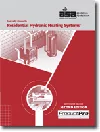Trade-show education
Radiant cooling is a great topic that is gathering momentum and interest from around the world.

Education is always a big draw for contractors, whether it’s at a local distributor’s facility, a manufacturer’s training center or an industry convention. At the 2016 AHR Expo held Jan. 25-27 in Orlando, Fla., the Radiant Professionals Alliance held its annual business meeting and educational offering — seven unique classes that set some attendance records at this show.
The “No Sweat Radiant Cooling” class was standing-room only, attended by contractors, architects, students and engineers. Due to the bad weather in New England, one of the instructors was unable to be there, but another instructor did step up and take his place.
Radiant cooling is a great topic that is gathering momentum and interest from around the world. Probably one of the industry’s biggest fears regarding radiant cooling is the possibility of producing condensation on either the radiant surface or the associated piping. This class dispelled a lot of these myths and showed contractors the proven formulas of success. Radiant cooling can only handle the sensible loads and, depending upon the actual load requirements, may not be able to handle 100% of those loads.
This technology has been proven as an energy-saving, comfort-generating alternative in commercial markets for many years, with one of the earliest applications at an airport in an extremely hot, humid climate — Singapore — more than 20 years ago.
The old adage about hydronic radiant heating being confined to north of the Mason-Dixon line is no longer true. We now have the ability to provide heating and cooling, radiant style, in a far wider range of climates. The days of having to purchase two different systems to provide year-round comfort no longer applies, either.
Another well-attended, standing-room-only session was “How to Specify Hydronic Systems.” This class, which also was heavily attended by contractors, as well as engineers and architectural types, covered how to:
- List the basic components of hydronic radiant heating, cooling and hybrid air systems while showing good specification language;
- Describe the process for calculating outputs of hydronic radiant systems — heating, then cooling;
- Relate examples where specifications were written incorrectly; and
- Summarize the elements of an appropriate specification for hydronic radiant heating, cooling and hybrid air systems.
This class was scheduled to run for 90 minutes, but due to the many questions being asked afterward, it ran for nearly two hours. The questions asked were topical and showed that there is a lot of interest in these systems. This should be a note of interest to the hydronic equipment manufacturers reading this column — there is a need to provide quality training and education as it pertains to hydronic radiant and conventional heating and cooling systems. The RPA and our educational partners are working hard to provide this service to the industry.
In fact, if you weren’t able to make it to the AHR conference, fear not. We have decided to bring these courses into a pay-per-view online program, with continuing education credits for those who are in need of them, through our Webex system. When they are available, we will announce their availability and pricing.
In addition to the above classes, the “NAECA and Not Afraid” presentation focused on the recent changes to the National Appliance Energy Conservation Act, showing contractors how to capitalize on the new energy-efficiency codes and standards. This well-attended class was chock full of excellent questions from the learning public. This is another class we will add to our webinar series in hopes of allowing interested parties the opportunity to see what they missed.
The 2017 AHR Expo will be held in Las Vegas, Jan. 30-Feb. 1, and I hope you will come to enjoy these learning experiences live. You’ll also be able to look at products, talk to manufacturers and see some live demos.
I’d like to personally thank all our volunteer instructors who took the time to put these AHR classes together and helped us present the RPA in a very professional manner. We couldn’t have done it without you.
The RPA’s primary function has always been one of education; education of consumers, architects, engineers, contractors, government officials and anyone with an interest in delivering the highest quality of comfort while maintaining the highest level of efficiency possible. Our intent is to raise the bar, which is good for the industry as a whole. We want to develop classes that interest and fulfill a need for not only our members but the whole radiant and hydronics industry.
In-person sessions such as those at AHR give contractors the opportunity to ask questions and get help with problems they see in the field. Through our partnership with HeatSpring we offer online classes that allow busy contractors to learn about radiant and hydronic systems, equipment and techniques when it’s convenient for them. These classes are a key part of the ASSE/IAPMO Series 19000 ANSI standard Hydronic System Installer certification program we are putting together. More on that in a future column.
If you are not yet a member of this fine organization, please join today. There is strength in numbers. This is an organization of the members, by the members, for the members, with all members benefitting from our collective actions.
Looking for a reprint of this article?
From high-res PDFs to custom plaques, order your copy today!







